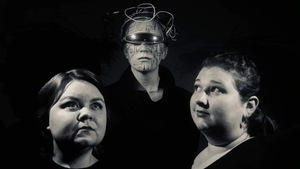Those who missed organist Mark C. Jones’s recital on the massive Dan Jaeckel organ at the Porter Center, Brevard College might want to be on the lookout for his next appearance, for this musician is special. Soft spoken and with a self-deprecating sense of humor, his humility belies his great talent. His program was a treat from start to finish, exploring a range of organ compositions from Bach through contemporary music for organ and prepared tape. Some of his own works revealed another praiseworthy facet of his creativity. Each was rendered with an impeccable attention to musical detail, especially articulations and registrations, revealing an experienced artist who knows how to size up the acoustics of the hall, choose a winning program, and play it well.
A graduate of A.C. Reynolds High School, Asheville, Jones studied organ with Dr. Marilyn Keiser and with Donna Robertson at Mars Hill College and now is Director of Music and Organist at the First Presbyterian Church of Pompano Beach, Florida. In 2006 he was appointed Principal Accompanist for the von Trapp Children, and played on the piano as a delightful sort of aside “Clair de Lune,” remarking that this was a favorite solo of his to play during their costume change.
The program opened with his Trumpet Tune in D, a short wedding processional that not only works as functional music but was also interesting musically. Later came more liturgical works in the form of three Hymntune Preludes — his slow, meditative arrangements of “What a Friend We have in Jesus” and “My Faith Looks Up To Thee,” capped by Robert Hebble’s more experimental arrangement of “Simple Gifts.”
A trio of Bach works was well chosen — the chorale prelude “Nun freut euch, lieben Christen gmein” (S. 734), featuring a bustling, glittering treble obbligato and walking bass with pedal melody, an adaptation of his famous “Air on the G string” from Orchestral Suite No. 3 in D (S. 1068), with lovely improvised Italianate ornaments, and the Toccata in D (Dorian, S. 538), noteworthy for its beautiful melodic shapes executed through a range of articulations and agogic accents.
A charming Allemande by Maurice Greene (1696-1755), distinguished London-born composer and organist, was sandwiched between two large works, the Mendelssohn Organ Sonata No. 3 in A, Op. 65 No. 3 in two movements (Con moto maestoso and Andante tranquillo), and “Carillon” by Vierne that closed the first half. Another technically taxing work by Vierne, the colorful “Finale” from his Symphonie No. 1, Op. 14, ended the program with a flourish.
The showstopper was a piece that was fortuitously programmed in the wake of the earthquake disaster in Haiti. Larry King’s “Revelations of St. John the Divine” for organ and prepared tape is a single-movement programmatic work in three sections based on selections from the Book of Revelation. The first section depicts the eternal nature of God who is ever with us (“I am the Alpha and the Omega”) in music of soft sustained tones partly achieved by the insertion of four pencils to hold down keys. The second depicts the cataclysmic earthquake (“And there were flashes of lightning, voices, peals of thunder, and a great earthquake such as had never been since men were on the earth”) via taped roaring winds and vocalizations, and agitato dissonant organ chords. In the final section, order and peace are restored with legato triadic harmonies and taped bird calls (“For the Lamb in the midst of the throne will be their shepherd, and he will guide them to springs of living water; and God will wipe away every tear from their eyes”). Who could not hear this music with new ears after all the dreadful news of late? My only complaint is that Jones was unduly apologetic to the audience about its contemporary sounds.
The bonbon before the final Vierne was Louis LeFébure-Wély’s (1817-1869) “Bólero de Concert,” Op. 166 an appealing, exotic piece that sounded for all the world like a cross between theater and calliope music.











